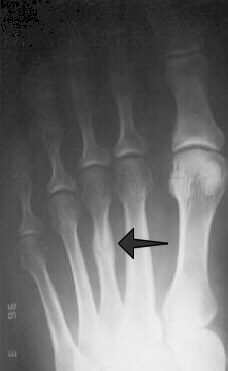| FOOT
DISORDERS - Stress
Fracture |
A stress fracture is a
break in a bone caused by repetitive stress. It may occur in any bone, but is
quite common in the metatarsal bones of the foot. There is often no recollection
of injury. The patient may simply develop a painful forefoot after some
activity, such a walking, sports, or stooping down onto the ball of the foot. A
small crack develops in the cortex (outer shell) of the
bone. Without proper treatment, this may progress to a "through and
through" (overt) fracture of the bone. The second and third
metatarsals are the most commonly affected. Metatarsal stress fracture may not
become apparent on x-rays until a few weeks after the injury.

- Sharp pain in the forefoot, aggravated by
walking
- Tenderness to pressure on the top surface of
a metatarsal bone.
- Diffuse swelling of the skin over the
forefoot.
- Bruising or redness of forefoot
- Decreased density of the bones (e.g..
osteoporosis)
- Unusual stress on a metatarsal due to
mal-position or another forefoot deformity (e.g.. bunion)
- Abnormal foot structure or mechanics (e.g..
flatfoot)
- Increased levels of activity, especially
without proper conditioning
- Obesity
- Seek professional help as soon as possible
- Keep weight off the foot
- Ice the top surface of the forefoot for
about 20 minutes every hour.
- To reduce swelling, wrap the foot in a
tensor bandage with moderate compression.
- Wear a shoe with a very stiff sole.
- Take x-rays to look for fracture
- Order special diagnostic bone scans to
establish a diagnosis
- Apply orthopedic taping and padding to
relieve stress from the metatarsals.
- Dispense a surgical/ trauma shoe or walking
brace to splint the foot.
- Prescribe medication for pain and
inflammation.
- Use physical therapy in the later stages of
healing.
- Morton's neuroma
(benign tumor of a nerve running between the metatarsals)
- Metatarsalgia (pain
and inflammation of the metatarsal bones and their soft tissue sheath)
- Capsulitis (painful
and inflammation of the joints between the metatarsal bones and toes)
- Tendonitis
(inflammation of the tendons which course along the top of the foot)
- Dislocation of a
joint between a metatarsal and a toe (metatarsal-phalangeal joint)
- Severe plantar callus
(hard thick skin on bottom of the foot)
- Bursitis
(an inflamed fluid-filled sac often between a bone and an area of pressure)


